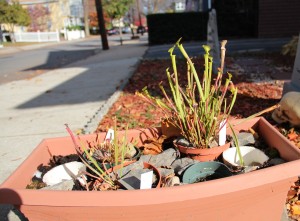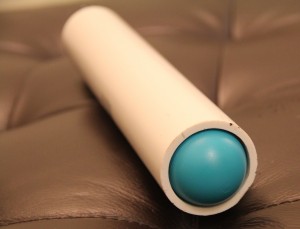I’ve been growing some small carnivorous plants (mainly Nepenthes and sundews) in a tank indoors, but a couple years ago, just for fun I started some Sarracenia (pitcher plant) seeds. Well, what do you know, the darned things actually grew. So this spring, when it was clear I wouldn’t be able to keep them in small pots or winter them over in a fishtank anymore, I put together this freestanding outdoor minibog.
For this first attempt, I picked up a pretty standard (you could even say, “bog standard”, harhar) rectangular planter without drainage holes, put a couple inches of gravel in the bottom, stood a couple pieces of 4″ PVC pipe on the ends, then filled it up with sphagnum peat moss. Well, since the planter was much deeper than the plant pots I was sticking in, I put a couple large rocks at the bottom to take up space too. A small overflow hole drilled just below the soil line prevents it turning into a pond.

This first cut worked out all right. The peat stayed plenty wet with only a bit of watering during dry spells, and water wicked into the pitcher pots (through peat-peat contact via the drainage holes) well enough despite being plastic. The PVC pipes, intended to take up space and provide a place to sink a couple 1L pop bottles as an emergency gravity-watering system, turned out to be unnecessary, and mostly a good place to grow mosquitoes.
Notes for next year:
On watering: The scheme with the PVC pipes (besides taking up the extra space in the planter) was that if the water table ever got to the very bottom and I was on vacation (or just forgetting to water the thing, because that’s something I would do), water-filled pop bottles notched at the bottom would slowly release their contents to maintain 1/4″ or so of water at the bottom (enough to keep things moist enough to stay alive, without immediately evaporating). It turns out the gravel alone works just as well for this. But I did like the fact that the pipes gave an easy visual indication of the water level in the minibog, and a quick way to fill ‘er up. So for next year, a mosquitoproof watering hole / level indicator: It turns out that 1.5″ PVC and a pingpong ball are an almost perfect fit: juuuust enough clearance for the ball to float freely, but not enough to let flying pests reach the water. Brilliant!

On wintering (to move or not to move): So far I’ve been providing winter dormancy for various plants by keeping them in a fishtank in a cold room of the house. Except for one N. purpurea (Home Depot rescue), I’ve got nothing that’s winter-hardy where I live (USDA zone 5). Reading up on the subject, it looks like people are successfully wintering not-so-hardy pitchers here if they are dug into the ground (no freestanding pots) and mulched. So next year I might take this bog and sink it into the ground, for plants that can be wintered outdoors, and make a smaller one that can easily be brought inside for the tropical stuff (I stuck a Nepenthes in the bog for the season, and it seemed to like it). Keep the pingpong ball watering scheme for both. I’m hoping with the infrastructure of a bog underneath, the fishtank will no longer be necessary for maintaining humidity or keeping things wet over the intervals I remember to water them. (That, and it looks like the fishtank is needed for actual fish now.)
More on moving: Another reason to bury this one is this design of planter was apparently not really intended to be full of water: after a couple seasons, it’s really starting to bow out in the middle.
On wildlife: Something(s) just love to go in there and dig little holes everywhere. I can’t really tell whether it’s squirrels, birds or both. Likewise, when I tried starting some live Sphagnum on the top, it was quickly dug out and removed (probably by nesting birds). In the end I had to cover most of the surface with good sized rocks to keep it from looking like a minefield. Sprinkling the surface with cinnamon and cayenne pepper powder had no effect. Next year, possibly some better wildlife protection scheme…
Leave a Reply